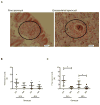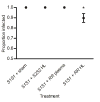Clearance of schistosome parasites by resistant genotypes at a single genomic region in Biomphalaria glabrata snails involves cellular components of the hemolymph
- PMID: 29137971
- PMCID: PMC5893386
- DOI: 10.1016/j.ijpara.2017.08.008
Clearance of schistosome parasites by resistant genotypes at a single genomic region in Biomphalaria glabrata snails involves cellular components of the hemolymph
Abstract
Schistosomiasis is one of the most detrimental neglected tropical diseases. Controlling the spread of this parasitic illness requires effective sanitation, access to chemotherapeutic drugs, and control over populations of the freshwater snails, such as Biomphalaria glabrata, that are essential intermediate hosts for schistosomes. Effectively controlling this disease, while minimising ecological implications of such control, will require an extensive understanding of the immunological interactions between schistosomes and their molluscan intermediate hosts. Here we histologically characterise the clearance of schistosome larvae by snails that exhibit allelic variation at a single genomic region, the Guadeloupe resistance complex. We show that snails with a resistant Guadeloupe resistance complex genotype clear schistosomes within the first 24-48 h, and that this resistance can be transferred to susceptible snails via whole hemolymph but not cell-free plasma. These findings imply that Guadeloupe resistance complex-coded proteins help to coordinate hemocyte-mediated immune responses to schistosome infections in Guadeloupean snails.
Keywords: Biomphalaria glabrata; Hemocyte; Hemolymph transfer; Histology; Plasma transfer; Resistance; Schistosomiasis.
Copyright © 2017 Australian Society for Parasitology. Published by Elsevier Ltd. All rights reserved.
Figures




References
-
- Adema CM, van Deutekom-Mulder EC, van der Knaap WP, Sminia T. NADPH-oxidase activity: the probable source of reactive oxygen intermediate generation in hemocytes of the gastropod Lymnaea stagnalis. J Leukoc Biol. 1993;54:379–383. - PubMed
-
- Adlard RD. Histology and Anatomy-pathology of Molluscs: A Guide for Diagnosticians. European Community Reference Laboratory; Ifremer, La Tremblade, France: 2003.
-
- Allan ER, Habibi HR. Direct effects of triiodothyronine on production of anterior pituitary hormones and gonadal steroids in goldfish. Mol Reprod Dev. 2012;79:592–602. - PubMed
-
- Allan ER, Tailor P, Balce DR, Pirzadeh P, McKenna NT, Renaux B, Warren AL, Jirik FR, Yates RM. NADPH oxidase modifies patterns of MHC class II-restricted epitopic repertoires through redox control of antigen processing. J Immunol. 2014;192:4989–5001. - PubMed
Publication types
MeSH terms
Grants and funding
LinkOut - more resources
Full Text Sources
Other Literature Sources

